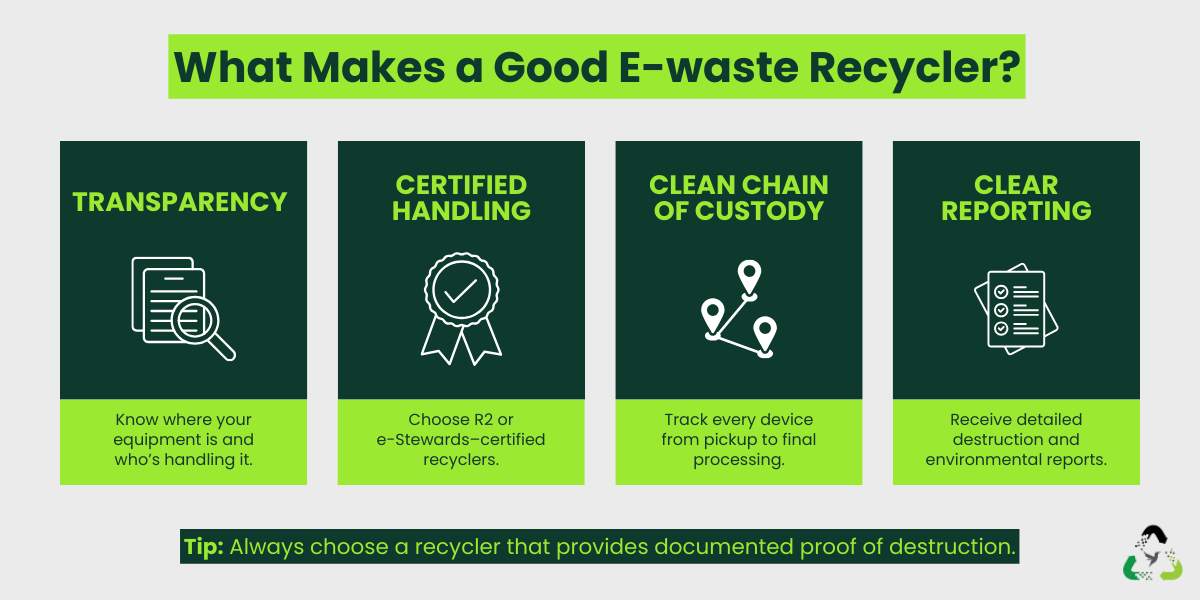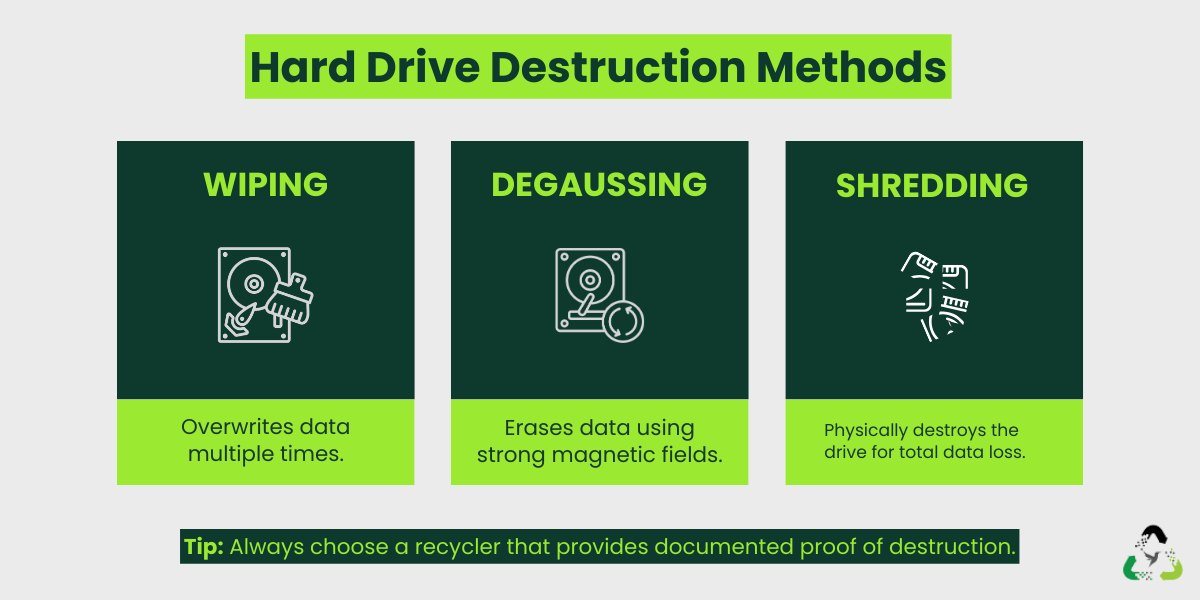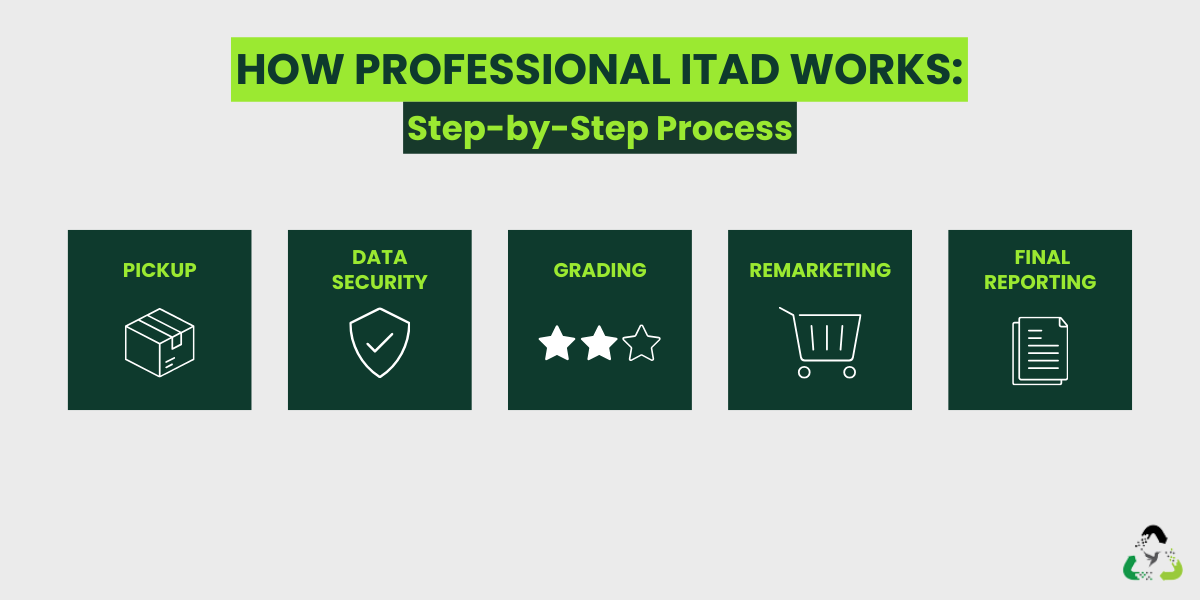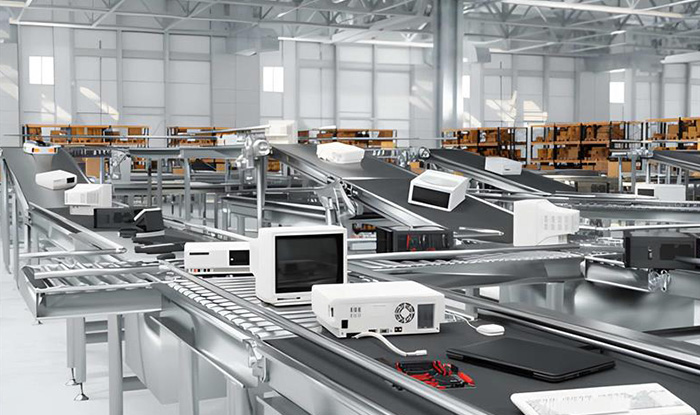What Makes a Good E-Waste Recycler
A good e-waste recycler makes the entire offloading process feel orderly rather than stressful. Since you are trusting them with old hardware, sensitive data, and your company’s reputation, the basics have to be solid.
Here’s what separates a reliable recycler from the rest:

-
Transparency
You should always know where your equipment is, what’s being done with it, and who is handling it. Clear communication prevents surprises and gives confidence that nothing is being mishandled.
-
Certified handling
Look for recyclers with recognized certifications like R2 or e-Stewards. These show they follow industry standards for safe dismantling, proper disposal of hazardous components, and secure data destruction.
-
Clean chain of custody
Every device should be tracked from pickup to final processing. A well-documented chain of custody reduces the risk of lost devices, data leaks, or compliance issues.
-
Clear reporting
After processing, you should receive detailed reports — from certificates of data destruction to environmental summaries. This not only helps with audits and ESG goals but also proves that retired devices are handled responsibly.
These qualities are not just nice to have. According to a 2023 ITAD industry survey, over 60% of businesses reported uncertainty about where their retired IT actually went, highlighting how critical transparency and documented handling are.
When a recycler delivers on these fronts, you can monetize retired IT assets safely, reduce risk, and ensure your organization’s e‑waste is managed with care and accountability.
Inside the Toolbox: Core E-Waste Terms Explained
Every service offered by a professional, certified ITAD partner has a clear purpose. From securing data to recovering value and tracking materials responsibly, these are the key terms you need to understand when managing retired IT assets. Knowing what each service means can help you see how a recycler turns a complex process into a structured, accountable workflow.
- Device Pickup and Logistics: Efficient collection tailored to your schedule, ensuring equipment is transported safely to the recycler.
- On-Site vs Off-Site Processing: Some tasks, like sensitive data destruction, can happen at your facility (on-site), while others, like material recovery, are handled off-site at certified centers.
- Secure Data Destruction: Protect sensitive information through certified wiping or physical destruction of storage media, with proof of completion.
- Device Grading and Testing: Assessment of each device’s condition to determine whether it can be refurbished, resold, or recycled.
- Inventory Reporting and Chain-of-Custody Logs: Detailed records of every device, tracking it from pickup to final processing to maintain accountability.
- Environmental Reporting and Compliance Support: Documentation of materials processed and recycled, supporting internal audits and ESG reporting requirements.
- Certificates of Data Destruction / Recycling: Official proof that sensitive data was erased and that materials were responsibly handled.
- Material Recovery and Responsible Recycling: Safe separation of metals, plastics, and other components, ensuring hazardous parts do not end up in landfills.
- Remarketing and Value Recovery: Devices in good condition can be refurbished or resold, allowing you to recoup some of the initial investment.
- Corporate Donation Programs: Equipment suitable for reuse can be shared through ITAD-compliant laptop donation, allowing devices to reach schools, nonprofits, or community initiatives.
- Parts Harvesting: Salvaging functional components from old devices to extend their lifecycle or support refurbishment.
- Final Downstream Verification: Confirmation that all devices and materials were processed through verified, responsible channels, completing the accountability loop.
This structured approach ensures that every piece of retired IT is treated with care, data is protected, value is maximized, and environmental impact is minimized — making the recycling process both efficient and trustworthy.
A Breakdown of Professional E-Waste Services
Below, we break down the main services a professional e-waste recycler should provide, so you can see exactly how each step contributes to safe, ethical, and efficient IT asset management.

-
E-Waste Collection / Pick-Up Services
Many recycling companies expect you to drop off your old devices at their facility. For busy households or organizations, this can be a major deterrent. Offering doorstep collection removes that barrier and encourages proper recycling.
Whether it’s a single laptop from home or dozens of desktops from an office, a reliable recycler coordinates logistics to make the process simple, safe, and trackable. Pickup services also include packaging guidance and secure transport so that devices arrive at the facility intact.
-
Responsible IT Asset Disposal
Proper disposal is more than tossing devices into a shredder. Some recyclers give false assurances, and electronics can end up in informal recycling operations overseas, sometimes involving unsafe labor. A trustworthy recycler handles every device responsibly.
Key disposal types include:
- Monitor/LCD Disposal: Safely dismantling screens and separating hazardous components like mercury.
- Computer Disposal: Securely breaking down desktops into recyclable parts, ensuring no sensitive data remains.
- Laptop Disposal: Similar to computers, but with attention to compact, sensitive storage media.
- IT Disposal: Covering all miscellaneous electronics — routers, servers, printers — handled according to compliance standards.
- Hard Drive Disposal: Certified destruction through shredding, crushing, or wiping to prevent data leaks.
-
Commercial and Residential Disposal
E-waste comes from all corners — homes, offices, schools, and large enterprises. A comprehensive recycling service caters to both residential and commercial clients, ensuring every device is processed safely and responsibly.
- For businesses, this service aligns with corporate social responsibility and regulatory compliance, helping organizations demonstrate ethical disposal practices.
- Residential programs focus on convenience, offering easy drop-off or pickup options so individuals can recycle without hassle.
By providing solutions for both types of clients, professional recyclers ensure that electronics at every scale — from a single home laptop to entire corporate fleets — are handled correctly and ethically.
-
Hard Drive and Data Destruction Services
Every storage device, from hard drives to SSDs and other digital media, contains sensitive information that must be protected. Professional recyclers ensure that data is completely unrecoverable while maintaining compliance and accountability.
Certificates of completion or proof of destruction are provided to confirm the process. This protects personal information, business secrets, and customer data, reducing risk for both individuals and companies.
Common destruction methods include:

- Wiping: Overwriting the device multiple times to remove all stored data.
- Degaussing: Using magnetic fields to erase data from storage media.
- Shredding: Physically breaking the drive into pieces, making data recovery impossible.
When selecting a recycler for secure data destruction, look for documented proof or client testimonials confirming consistent, reliable handling of data-sensitive devices.
How These Services Work Together
A professional recycler treats every service as part of one connected process. Each step builds on the last, creating a clean, traceable path for every device.
Here’s how it typically looks:

-
Pickup and Chain-of-Custody Logging
The process starts with a scheduled pickup. Every asset is tagged, logged, and transferred under a documented chain of custody so nothing goes unaccounted for.
-
Data Security and Drive Handling
Once the equipment reaches the facility, the data team handles all storage media first. Drives are wiped, degaussed, shredded, or crushed before anything else moves forward.
-
Grading, Testing, and Inventory Review
Devices are then inspected, graded, and tested. This stage shows what can be reused, what needs repair, and what should go straight to responsible recycling.
-
Remarketing, Donation, or Material Recovery
Based on the grading results, items may enter resale channels, donation programs, parts harvesting, or certified recycling streams.
-
Final Reporting and Documentation
Every action taken along the way is recorded. The final report includes chain-of-custody logs, data destruction proof, environmental reporting, and certificates.
This structured flow gives organizations a full lifecycle view of their retired IT assets and ensures nothing is left to guesswork.
How E-Waste Solutions Serve Every Role in Your Organization
E-waste management isn’t a one-size-fits-all process. Different teams within an organization gain value from different services, whether it’s protecting sensitive data, recovering financial value, meeting sustainability goals, or simply keeping IT operations running smoothly.
Mapping these services to the right stakeholders can help everyone understand who benefits from what, making it easier to choose a certified ITAD partner, prioritize actions, and ensure every device is handled responsibly.
The table below shows the main stakeholders and the services that matter most to them, showing the practical impact each service delivers.
| Stakeholder | Key Benefits from E-Waste Services |
| CISO (Chief Information Security Officer) | Protects sensitive data through secure destruction, on-site/off-site processing, chain-of-custody logs, and certificates. Ensures compliance and audit readiness. |
| CFO (Chief Financial Officer) | Maximizes asset value with grading, remarketing, and parts harvesting. Gains financial transparency via inventory reports, audit logs, and predictable pricing. |
| ESG / Sustainability Officer | Tracks environmental impact with material recovery, responsible recycling, laptop donation programs, and compliance reporting. Supports ESG goals and landfill diversion. |
| IT Manager | Simplifies operations through device pickup, grading, testing, and inventory reporting. Speeds up processing and ensures smooth IT asset workflow. |
The Real Risks of Skipping Proper E-Waste Management
Wonder what happens when organizations put e-waste on the back burner? The problems often show up later and hit harder than expected. Data leaks, unexpected costs, compliance pressure, and environmental damage all stem from small oversights that pile up.
Each risk below reflects what happens when devices are handled without structure, reporting, or certified processes, and how the right service closes the gap before trouble begins.
-
Cybersecurity Exposure
When retired devices sit in storage or move through unofficial hands, the information inside them stays vulnerable. It may be years old, but it can still contain customer records, confidential emails, internal documents, or login details.
- In a study of 122 second-hand hard drives and SSDs, 48% had residual data, even though many were supposedly “wiped.”
- Another test of 200 used drives bought online found 78% still contained personal or business data despite being resold or refurbished.
Many breaches start with discarded hardware that was never wiped or was only wiped once without verification. This puts the business at risk of legal claims, reputation damage, and long investigations that drain time and resources.
The Solution
A recycler offering secure data destruction solves this by handling every device with a strict process. Wiping, degaussing, shredding, and verified destruction ensure no information can be recovered. A clean chain of custody protects the device from the moment it leaves your building, while certificates of destruction give you written proof that the risk is closed for good.
-
Landfill Overflow and Environmental Harm
Old laptops, monitors, and phones contain materials that do not belong in landfills. Plastics, metals, and chemical components can leach into soil and water once they break down. When companies or households skip certified disposal, this waste often ends up in landfills that are already struggling to manage rising volumes. The long-term impact shows up in polluted sites, unsafe air quality, and increased pressure on communities that live near dumping grounds.
- In 2022, global e-waste generation reached 62 million tonnes, but only 22.3% was formally collected and recycled.
- The recycling rate is projected to fall even below 20% by 2030 if the gap between e-waste generation and recycling efforts widens.
The Solution
A responsible recycler prevents this by directing every material to the correct downstream partner. Items suitable for reuse are recovered. Items that can be broken down are separated and processed safely. Any remaining components are handled under documented environmental standards. These services keep waste out of landfills and maintain traceability, so you know where everything goes.
-
Hidden Disposal Costs
Improper e-waste disposal often looks convenient at first, but it becomes expensive when problems surface. Storage rooms fill up with unused equipment. Emergency disposal pickups cost more than scheduled recycling. Businesses may pay twice, once for disposal and again for damage control when a forgotten device causes a breach or a compliance issue. Even small mistakes in sorting or transporting devices can create avoidable expenses.
The Solution
Using a structured pickup and recycling service reduces these hidden costs. A recycler that offers predictable pricing, itemized reporting, and scheduled pickups helps you keep track of inventory without clutter. Clear processing steps prevent unnecessary spending and eliminate guesswork. When everything is handled at the right time, you avoid the financial surprises that come from rushed or careless disposal.
-
Compliance and Audit Failures
Many organizations face strict rules around data handling, environmental reporting, and disposal practices. When devices are discarded without proper logs, certificates, or verifiable processes, audit teams often flag missing steps. This creates delays, corrective actions, and in some cases, penalties due to state-by-state e-waste legislation. Compliance failures also dent internal credibility, especially when technology teams must explain incomplete documentation.
The Solution
A certified recycler solves this by providing detailed audit trails, from chain-of-custody logs to certificates of recycling and data destruction. These documents show exactly how each device was handled. Environmental reporting supports ESG requirements, while predictable processes help teams meet audit timelines without scrambling for missing proof.
-
Lost Asset Value and Poor Recovery Rates
Retired laptops and other devices retain resale value if appropriately processed. When old equipment is stored too long or handed to a recycler without proper grading, much of that value disappears. Missed remarketing opportunities reduce return on investment, while poorly managed retrieval makes businesses spend more on replacements.
The Solution
A strong recycler protects this value through proper testing, grading, and a clear laptop retrieval service that brings devices back into circulation quickly. Remarketing channels help recover costs, and accurate grading ensures every item is evaluated fairly. This approach turns outdated equipment into a financial return instead of letting it fade into storage closets or scrap piles.
-
Unsafe Informal Recycling Channels
When devices enter informal recycling streams, they often end up in unsafe dismantling sites in developing regions. Workers, including children, may handle toxic components without protection. Open burning, crude extraction methods, and unregulated dumping create severe health risks and polluted environments. Businesses unknowingly contribute to these conditions when they choose recyclers without verified downstream partners.
- A 2021 scientific review estimated that around 82.6% of global e-waste is processed via informal or unsound recycling routes rather than formal, regulated channels.
The Solution
A certified recycler prevents this by tracing every item to credible processors. Downstream verification ensures no part of your e-waste is shipped to informal sites. Responsible recycling protects communities, eliminates unethical handling, and gives organizations confidence that their old equipment is not causing harm somewhere else.
Final Words
Proper e-waste management goes beyond just clearing out old devices. When services like secure data destruction, grading, remarketing, and certified recycling work together, organizations protect sensitive information, recover value, stay compliant, and reduce environmental impact. A structured approach turns retiring IT assets from a logistical headache into a smooth, accountable process.
Hummingbird International LLC supports organizations with this full-cycle approach, offering certified, accountable, and environmentally responsible e-waste recycling solutions.
FAQs
-
What services should an ITAD recycler offer?
A reliable recycler should cover secure data destruction, certified e-waste processing, pickup and logistics, inventory reporting, grading, remarketing, environmental reporting, and verified downstream handling. These services ensure your devices are handled safely from pickup to final recovery.
-
Do I need on-site hard drive shredding?
Not always. On-site shredding is helpful when the data is highly sensitive, and devices cannot leave the building intact. For most organizations, certified off-site wiping or shredding with a full chain-of-custody log offers the same level of protection.
-
How do I verify if a recycler is certified?
Check for recognized certifications such as R2v3 or e-Stewards, and ask for proof rather than relying on claims. A reputable recycler will share audit reports, certificates, and downstream partner information without hesitation.
-
Is remarketing always an option?
Only if the devices still have usable life. Items in good condition can be graded, tested, and sold to recover value, while older or damaged equipment usually moves straight to material recycling. The recycler should advise you honestly based on the device’s condition.
-
What does a recycling certificate include?
A proper certificate lists the devices processed, the date of recycling, the method used, and confirmation that all handling complied with environmental and data security standards. It provides documented proof for compliance and audit use.


Leave a Reply